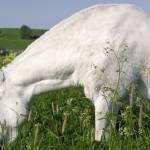Genetics of Swayback Investigated in Saddlebred Horses

Swayback, or lordosis, is a trait found in some horses with American Saddlebred bloodlines. Besides being unsightly, extreme lordosis can cause physical damage to the spinal cord and associated ligaments and tendons. However, moderate swayback does not seem to impact the horse’s usefulness, and does not cause lameness.
Research at the University of Kentucky’s Gluck Equine Research Center has uncovered a genetic marker on chromosome 20 that is significantly associated with swayback. In an analysis of 20 horses with swayback and 20 normal horses, 17 of the affected horses had the genetic marker.
The gene that leads to swayback is recessive, meaning that both parents must pass on the gene to allow the trait to show up in offspring. In a larger study that examined more horses, 80% of horses with the physical trait had two copies of the chromosome sequence. Surprisingly, among unaffected horses, 15% also showed two copies of the sequence though the horses appeared normal.
Ernest Bailey, Ph.D., a co-author of the study, emphasized that the genetic marker cannot be said to cause swayback, since not all horses with the marker are affected, but the discovery is nevertheless a major step in tracking down the genetic pattern that is to blame for the deformity.
If breeders choose to avoid using horses with the particular chromosome sequence, whether or not those horses exhibit swayback, their foals are much less likely to develop the condition. More research on genes, gene expression, and possible other causes of lordosis will give a clearer idea of the best way to eliminate this trait from the Saddlehorse breed.








